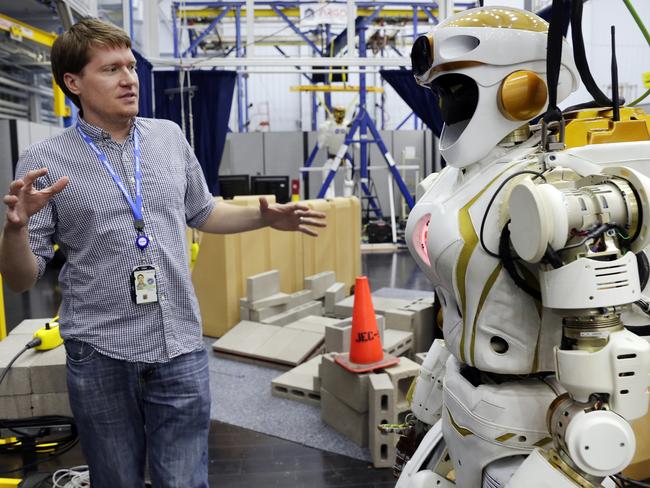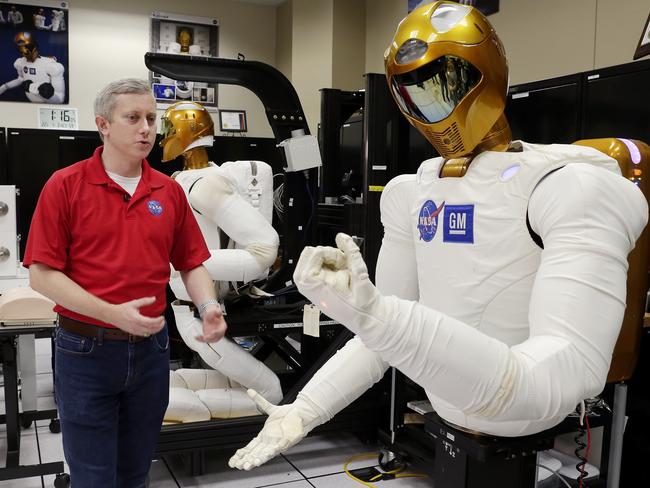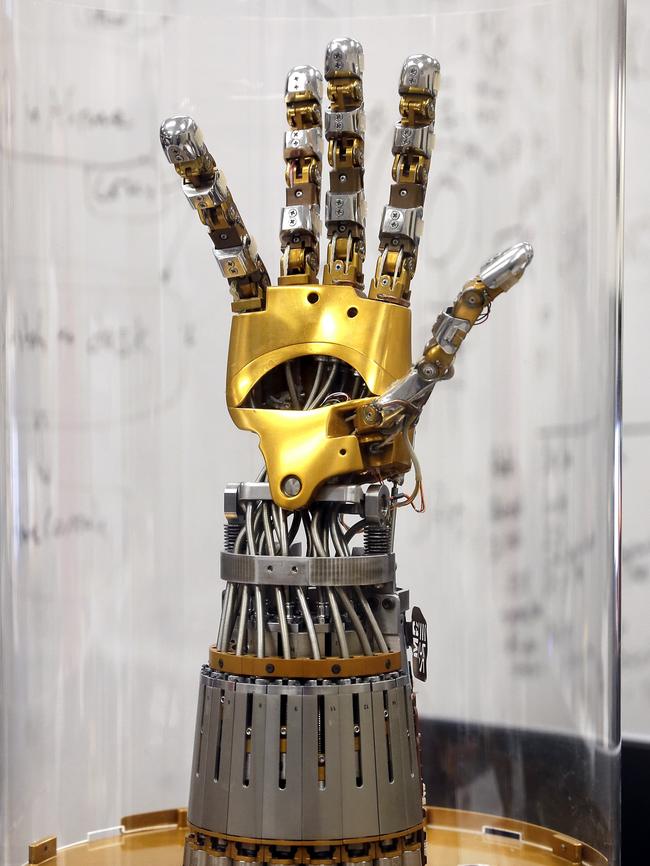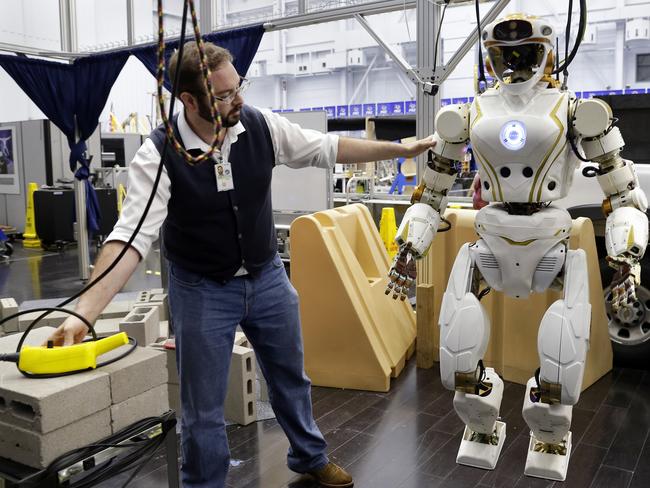Inspired by Star Wars, NASA will be using robots to help with all aspects of future space missions
Our first small step on the moon was lauded as a “giant leap for mankind” — but the next strides we make in space and lunar exploration will be made by robots. SEE THE VIDEO
Deep inside NASA’s booming robotics division, where some of the most vital components for a new generation of moon missions are being developed, there’s a strong 1970s vibe.
Because while the men and women building robots inside Building Nine at NASA’s sprawling Houston campus are working at the absolute forefront of technology, a lot of them are also (perhaps not surprisingly) huge Star Wars fans.
“We had the Star Wars research guys come in for their last film and they said: ‘We copy all your stuff’,” says one staffer.
“And it was funny, because we said: ‘We copy all your stuff!’.”
Robotics engineer Jonathan Rogers agrees: “I think we’ve had a lot of the same influences”.
“A lot of people will ask us what our inspiration was. Some of them see the Master Chief character from Halo. Some of them see Star Wars.”
See how the robots work in our video above.

When NASA returns to the moon in just over four years, some of the most important work won’t be done by humans, but rather robots such as the strapping Robonaut, for which Mr Rogers is the deputy project manager.
There were no robots involved in the Apollo missions, which relied on more hands-on technology, a support staff of 400,000 and the ingenuity and quick thinking of the three-man crews who headed into space.
But technological leaps have driven a new approach to developing robotics in conjunction with upcoming exploration, making them “vital” to the success of the new Artemis missions, named for the twin sister of Apollo in Greek mythology.
This means the Gateway project, which will be the orbiting base for moon missions from 2024, is being developed in conjunction with NASA’s robotics team, rather than trying to fold the machines into an existing design as was mainly done with the creation of the International Space Station in the late 1990s.

Their main focus will be relieving astronauts from drudge work and filling in for humans, who are comparatively fragile in a high radiation space environment and need food, water and waste facilities at a minimum.
“Astronauts are very busy,” says Mr Rogers.
“We want robots and people to work side-by-side whether it’s in space or on assembly lines, to complement each other. In neither case do we want to replace people with robots, but we think that there are synergies.”
A regular work day aboard the International Space Station is an 11 hour shift “of which 8.5 is ‘operations’ — that generally means science experiments and space station maintenance and upkeep. The other 2.5 are for exercise,” according to NASA’s Brandi Dean.
As the ISS ages, maintenance is taking a greater chunk of astronaut mission time, and the aim is to avoid this happening with Gateway, which may only be manned for 30 days a year.


RELATED: It’s a long journey to get back to the moon
RELATED: Aussie stars share their memories of the moon landing
RELATED: Apollo 11 astronauts feared failure, not death
“The pay-off for robotics, at least inside the vehicle, is taking care of these tasks that need to be done, but don’t necessarily require the full intellect of a human,” he says. “So let’s have our crew members do the things that they’re good at, and let the robots do the boring things.
“If you look to traditional robotics, the three things that we always say they do are the three Ds. Dull, dirty, or dangerous tasks. And that translates perfectly to space flight.
“What Gateway has embraced is this vision where the crew comes and goes. So a resupply vehicle will show up to have supplies for the next crew that’s coming, or experiments, or whatever needs to be on-board.
“The robot will be able to unpack that vehicle, put everything where it needs to go, and then have it ready for the next crew to pop the hatch and get to work.”
Mr Rogers, 35, whose connection with NASA started as a teenage tour guide through his inclusion on a high school robotics team and then into a college internship, said having a hard date for “boots on the moon in 2024” had sparked a huge surge in activity at the space agency.
“It’s really inspiring. We had a similar atmosphere during the return to flight activities in, I guess it was about 2005, when Discovery flew for the first time after we lost the Columbia crew,” he says.

SHEER LUNAR-CY: The wackiest moon landing conspiracies
“People are excited. People feel motivated. There’s a lot of work towards common goals.
“It’s not that we haven’t had that before. Space station is a momentous accomplishment, and we’ve done many, many great things. But I think we are all very excited to get to go take the next step and stay on the moon.”
The robots who work on Gateway won’t necessarily look like Robonaut, with its biceps modelled on “Arnie (Schwarzenegger) at his peak” and a wingspan based on a Houston Rockets basketballer, or like its less masculine counterpart, Valkyrie.
Designed for on-ship activity, the hulking Robonaut is too heavy to carry its own weight on its foldable legs unless in a zero-gravity environment. Valkyrie is focused on working off-vessel on a planet surface, and was designed in the wake of the Fukushima nuclear disaster in Japan.
“The idea is that we want robots to go into these types of situations and try to effect change to either get eyes on, or cameras I suppose as it would be, on the situation to understand what’s going on,” Mr Rogers says.
“Or to, say, close a valve or open a door to mitigate the impending disaster. That was the application that we built it for, but in a NASA mission, that would be planetary habitats.”
Mr Rogers said the Robonaut and Valkyrie technology was “robot agnostic” but that while the new models wouldn’t necessarily look the same, they would likely have some “humanoid” characteristics.
“The humanoid aspect really resonates with people, and that’s important because we want to keep this interesting, and to keep encouraging as many young people as we can into this field,” he said.
